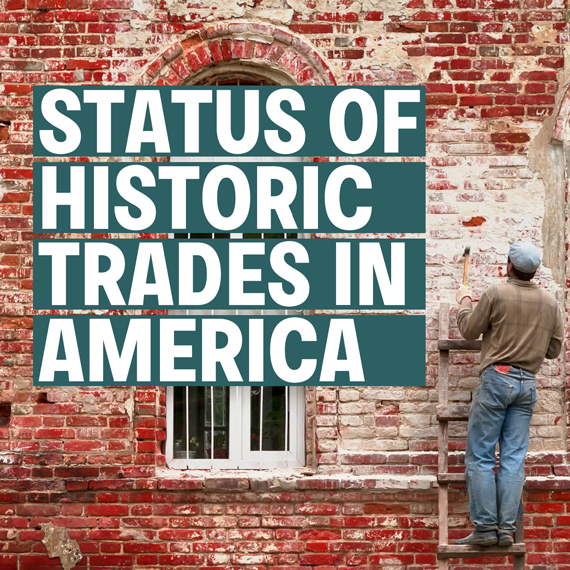|
First-of-its-kind labor study on historic trades in America
January/February 2023
Recent analysis of The Campaign for Historic Trades, a national workforce development program, shows the need for a larger and better-trained historic trades workforce; 100,000 workers will be needed within the next decade to preserve and maintain precious historic resources in San Diego and across the country.
In December 2022, The Campaign for Historic Trades announced the completion of a first-of-its-kind labor study on the status of historic trades in America. As the premiere preservation organization in San Diego, SOHO is pleased to partner with The Campaign to highlight the investment needed to develop a trained workforce to properly preserve and maintain the San Diego region’s unique historic assets.
 Courtesy Place Economics |
This study is believed to be the most comprehensive survey ever prepared on the status of the traditional trades in the United States.
Bruce Coons, SOHO’s executive director, said, “The study significantly shows that historic preservation is a major component of the construction industry and highlights the need for historic preservation trades workers in San Diego and throughout California. SOHO’s online Old House Resource Directory includes trained tradespeople with long waiting lists. The study underscores why San Diego should invest in the workforce that will sustain this growing need.”
The Campaign for Historic Trades is powered by the statewide non-profit Preservation Maryland in partnership with the National Park Service’s Historic Preservation Training Center. As part of its mission to identify and resolve systemic barriers to historic trades careers, The Campaign sought to define historic trades occupations and ascertain the current and future market need for trained tradespeople. With this new study, conducted by Place Economics—a firm with decades of experience in the analysis of the economic impact of preservation—and the data it provides, the gap between the need for historic preservation trades workers and the trained hands to perform the work is accurately measured and forecasted for the first time in history. The data also make a strong case for funding The Campaign.
Key Findings
The portion of the construction industry that is focused on historic rehabilitation is large and growing. Heritage trades make up an estimated 12.6% of all building rehabilitation jobs. Both the number of buildings considered historic and the amount of money invested in their rehabilitation are on upward curves. But there is a serious shortage of workers who are trained and experienced in the historic preservation trades.
- Nearly 2 million commercial buildings, 35 million residential buildings, and over 2 million multi-family buildings—that is, almost 39 million of 96.1 million structures in total—in the United States were built at least 50 years ago.
- Each year, approximately 261,000 of these properties undergo rehabilitation projects that require experienced heritage trades workers—that is nearly 100,000 highly specialized trades workers needed over the next decade.
- In 2021 alone, the total investment in historic buildings is estimated to be nearly $37 billion, and historic rehabilitation activity is expected to create close to 166,000 direct jobs annually.
The rehabilitation of historic buildings is a labor-intensive activity, meaning a high share of the total expenditure goes to labor. These projects create more localized jobs compared to new construction activities.
- For every 10 direct jobs created by rehabilitating a historic building, another 1.8 to 2.4 additional jobs are created elsewhere in the economy.
- On average, for every $100 in direct labor income an additional $186 is generated in paychecks for indirect and induced jobs.
- Additionally, $11.3 billion direct labor income is created by historic rehabilitation activity.
To read the full labor study, visit www.historictrades.org/laborstudy.
|
2025
2024
2023
2022
2021
2020
2019
2018
2017
2016
2015
|




